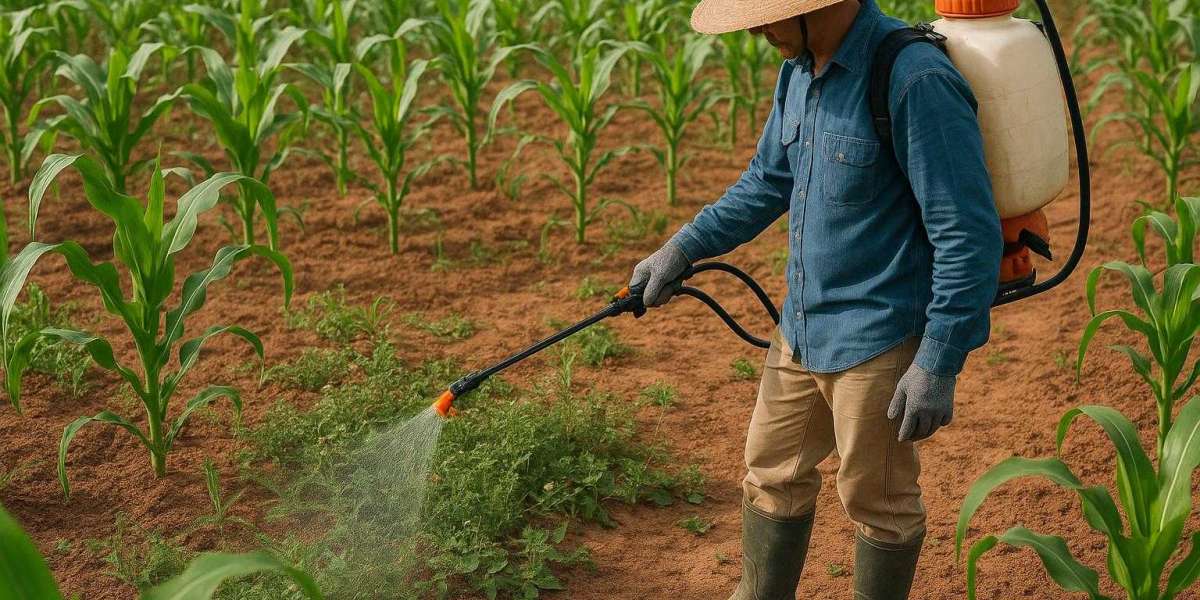1. Targets the Entire Plant System, Not Just the Surface
Non-selective systemic herbicides are absorbed through leaves and transported via the plant’s vascular system to the roots. This movement, called translocation, ensures that the plant dies completely—not just the visible parts.
In most trials:
- Treated weeds began yellowing within 3–5 days.
- Complete root kill was observed within 10–14 days.
By disrupting amino acid synthesis and metabolic pathways at a cellular level, these herbicides provide total plant destruction, preventing regrowth. This makes them especially useful for perennial weeds like Cynodon dactylon and Cyperus rotundus.
2. Suitable for a Wide Range of Use Cases
Whether you're managing weeds in orchards, roadways, industrial zones, or before planting crops, non-selective systemic herbicides are well-suited for various scenarios. Their versatility is one of the main reasons for their global popularity.
Common application areas include:
- Fallow fields and pre-plant land prep
- Railways, sidewalks, and urban landscapes
This adaptability makes them valuable tools in integrated weed management systems. Unlike mechanical weeding, which may leave root fragments behind, these herbicides eliminate the entire plant, even in hard-to-reach or uneven terrains.
3. Reduces Labor and Input Costs Significantly
Manual weeding is labor-intensive and unsustainable for large-scale operations. In a recent survey from Tamil Nadu, farms that replaced manual weed removal with systemic herbicides cut weeding costs by 62% on average. Labor time dropped from 30–40 man-hours per hectare to under 5 hours.
When scaled, the savings become substantial—according to a 2023 report by AgFunder News, farms using modern herbicide programs had 30% lower weed management costs compared to those relying solely on manual or mechanical methods.
Additionally, fewer applications are required due to the herbicide’s residual effect and root action, resulting in more efficient field turnover between crop cycles.
4. Prevents Weed Regrowth for Longer Durations
One of the key frustrations in weed management is the recurrence of weeds weeks after control measures. Non-selective systemic herbicides prevent this by disrupting the plant’s biological functions from the inside. The chemical reaches root nodes and stops rhizomatic regeneration, a common issue in perennial weeds.
After applying the herbicide in spring, many farmers reported:
- No weed regrowth for 30–45 days
- Over 85% weed suppression even after heavy rains
These long intervals of clean soil provide crops with an early growth advantage and reduce follow-up treatments.
Glyphosate-based herbicides are now frequently purchased online by professional turnaround and uniformity within this treatment spectrum. This makes it easier to provide prompt access to high-quality items that meet local regulations and planting dates.
5. Works in All Seasons with Proper Timing
Non-selective systemic herbicides are effective year-round but perform best when weeds are actively growing. Spring and early summer applications tend to produce the most consistent results due to increased metabolic activity in the plant.
Tips for optimized seasonal application:
- Apply during early morning or late afternoon for better absorption.
- Avoid spraying before rainfall to prevent runoff.
- Maintain consistent droplet coverage across the target surface.
In colder climates or dormant seasons, uptake may slow down. However, by combining the herbicide with adjuvants or using it as part of a larger rotation strategy, efficacy can still be maintained.
“Systemic herbicides don’t just kill weeds—they shift the biological balance in the field, allowing crops to thrive without underground competition.” – Dr. R. Prakash, Agronomy Specialist
6. Effective Against a Broad Spectrum of Weeds
Non-selective systemic herbicides eliminate the majority of annual, biennial, and perennial weed species, in contrast to selective herbicides that target specific weed categories. Both broadleaf and grassy weeds are included in this.
Common susceptible species include:
- Echinochloa crus-galli (Barnyard grass)
- Parthenium hysterophorus (Carrot grass)
- Ageratum conyzoides (Goatweed)
- Digitaria sanguinalis (Crabgrass)
They are helpful for clearing land prior to planting monoculture crops because of their wide-ranging effects. According to Madhya Pradesh experiments, using a single herbicide round to fallow land decreased weed biomass by 94%, allowing the field to be prepared for sowing in less than ten days.
7. Supports Integrated Weed Management Strategies
Modern weed control isn’t just about herbicides—it’s about combining cultural, mechanical, and chemical methods for sustainable management. Non-selective systemic herbicides are a cornerstone of these plans due to their reliability and predictability.
When used in rotation with other modes of action, these herbicides help prevent the development of herbicide-resistant weed strains. According to the Herbicide Resistance Action Committee (HRAC), rotating herbicide classes every season can delay resistance buildup by several years.
Some integration methods include:
- Using cover crops post-clearance to suppress regrowth
- Applying selective herbicides mid-season for emerging threats
- Combining with mulching to reduce light access for new weeds
These combinations create a hostile environment for weed development without relying on a single control method.
Unique Characteristics and Benefits Beyond Weed Control
While their primary use is vegetation management, non-selective systemic herbicides have additional benefits:
- Rhizospheric reset: By removing root structures, the herbicide allows restructured soil microbiota to flourish before sowing.
- Canopy breakthrough: Removes weed shading, improving sunlight penetration for young crops.
- Pest barrier: Reduces pest shelters by eliminating ground-cover weeds.
In precision agriculture, satellite data helps map weed density and optimize herbicide dosing. This leads to efficient usage, less waste, and better long-term field health.
FAQs
- What does “non-selective systemic” mean in herbicides?
It means the herbicide kills most vegetation types and moves within the plant to kill it entirely, including the root system. - Can I use these herbicides near desirable plants?
No, they will affect any plant they touch. Use with care and avoid drift. - How soon can I plant after application?
Wait 7 to 15 days, depending on weather and dosage. Always follow label recommendations. - Are these safe for the environment?
When used as directed, they bind to soil and degrade over time. Avoid over-application and follow safety measures. - Do I need protective gear when spraying?
Yes, wear gloves, goggles, and a mask to prevent inhalation and skin contact.
Practical Examples from Farmers and Landscapers
Before planting millet, a dryland farmer in Rajasthan cleared two hectares using a non-selective systemic herbicide. Within 12 days, weed cover decreased from 78% to less than 3%. Because there was less competition, crop emergence improved.
The pesticide was sprayed in an overgrown public park in Pune by a landscaping crew. All invasive species were eradicated in ten days. This made it possible to reintroduce native grass without having to uproot it by hand.
Consistent adoption in urban infrastructure and smallholder agriculture is being fueled by these results.
What's Next: Smarter Applications and Precision Control
The emphasis is moving towards more intelligent use of non-selective systemic herbicides, which are nevertheless crucial for controlling weeds. These days, drone-based apps, automatic dose calculators, and GPS-enabled sprayers are commonplace. These tools guarantee accurate targeting and lessen abuse.
New herbicide formulations are being developed with improved absorption rates and reduced toxicity profiles. These developments will further change how farms, communities, and institutions handle the problems posed by invasive plants when combined with data-driven weed mapping.








